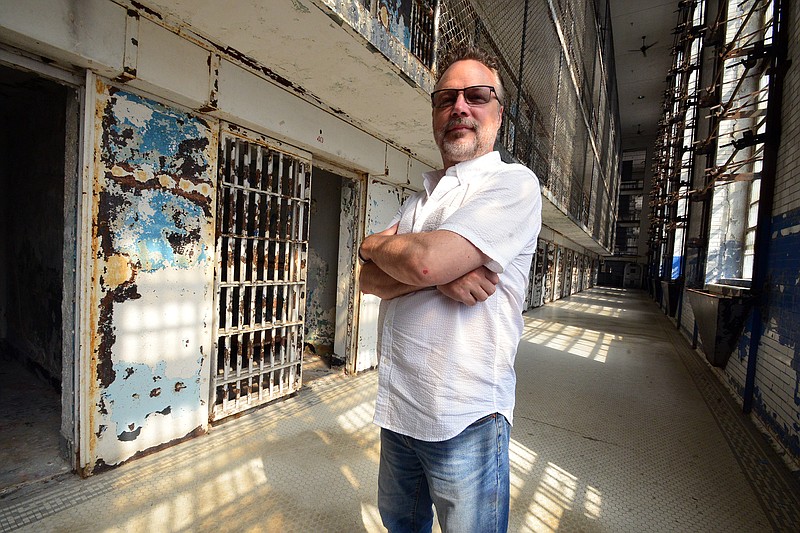Harry Snodgrass's name is one listed alongside arsonist John B. "Firebug" Johnson, socialist labor party activist turned prison reformist Katie Richards O'Hare and James Earl Ray.
But he did not cause more than $500,000 worth of property damage and inmate deaths at a state prison like "Firebug" or assassinate a civil rights leader like Ray, who was convicted of killing Martin Luther King, Jr. The mild-mannered, skilled pianist's name is part of the historic Missouri State Penitentiary's "infamous inmates," gaining his notoriety while serving three years on a robbery conviction in the 1920s at the now-closed prison and becoming a rising star of the prison band's performances broadcast live on the radio at the State Capitol.
Snodgrass's uplifting, ironic story and his music caught the eyes and ears of writer and film director Andrew Jones. He wants Snodgrass's name to rise in popularity once again by telling his story and sharing his music in a cinematic historical drama he co-wrote. He is also asking investors and donators to support this multi-million dollar nonprofit film venture so it can be filmed and produced in Jefferson City.
"This one is a big, big movie. it's quintessential Jefferson City. It primarily takes place at the Missouri State Prison and at the Capitol, and it takes place in 1923," Jones said. "It makes it challenging and it makes it expensive. But I think what it can do for tourism would be phenomenal; it is priceless."
Growing up as a fourth generation writer in San Diego and now working and living in Los Angeles, Jones had never stepped foot in Missouri until coming to Jefferson City in 2012 to work on his original horror film, "Haunting of Cellblock 11." The story follows a group of ghost hunters hoping to up their game in the competitive world of paranormal television shows, getting more than they bargained for while filming at a truly haunted prison.
"It was such a great experience that in 2016 when I was looking for another location, I found one here at Truman Hotel and we shot 'Darkness Reigns,'" Jones said. The film, which stars Casper Van Died from "Sleepy Hollow" and "Starship Troopers," and Linara Washington of "Haunting of Cellblock 11" and "Grey's Anatomy," follows a film crew haunted by a demonic force. The movie was recently released in July on VOD (Video On Demand) and available on many streaming platforms. "I had such a good time filming at the penitentiary. It was such a great experience and getting to know everybody locally and making friends. I still have very good friends from that production from right here in Jefferson City. I kept thinking, 'What else can we do?'"
Jones started researching and came across the horrific true story of the Greenlease kidnapping in the 1950s, involving a heroin addict and alcoholic who kidnapped and murdered a 6-year-old boy and were ultimately executed in Jefferson City for their offenses. Jones had the film script he wrote based on this Missouri incident, "81 Days," read on the Scene One Theatre's stage during the Missouri Film Office's Missouri Stories Scriptwriting Fellowship program held in early August. Even though he wants to produce "81 Days" in the future, he said something struck him and urged him to revisit Harry Snodgrass's story, which he had learned about during his research.
"About three or four months ago, I was hit with this bolt of lightning and said, 'Remember that Harry Snodgrass, you have to write that film,'" he said. "I stopped what I was doing, got my computer and started doing research. A little bit started coming back to me about how cool that story is, how uplifting. It is a story of redemption and amazing music. What is so great about the Snodgrass story, is it's a great story of irony."Jones dug deep in his research of Snodgrass, discovering the working musician in St. Louis enjoyed playing his highly skilled ragtime and jazz music at halls and venues and as accompaniment to silent movies. He also liked to drink heavily despite Prohibition. While inebriated and low on cash, Snodgrass listened to a fellow bar patron, who convinced him to help rob a candy store. The plan backfired, and Snodgrass was able to get away.
"Harry ran out of there and ran home, because he lived nearby. His wife didn't believe he robbed the store, and he was still drunk," Jones said. "To prove it to her, he picked up the phone, called the police and confessed. So he was sentenced to three years at the Missouri State Penitentiary."
Known as the "King of the Ivories," Snodgrass rose to fame while performing every Monday night as part of the prison band, or also known by the "Peaceful Village Band," on a local radio broadcast airing from the dome of the Capitol building. His popularity "exploded," Jones said, and Snodgrass received more than 300,000 telegrams, money, marriage proposals, gifts and much more and saw a more than 1,000-person audience attend his final performance as an inmate in 1925 within the House of Representative's chambers at the Capitol.
"He was considered America's first radio celebrity, and no one has ever heard of him. It all happened right here in Jefferson City," said Jones, who also spoke to Snodgrass's 94-year-old daughter-in-law to gain as much knowledge of the man as possible. "He played ragtime, he played jazz and he was an extraordinary piano player for this little, meek man who only had a seventh-grade education."
Jones contacted St. Louis actor and writer Peter Meyer, who also acted in "Haunting of Cell Block 11" and "Darkness Reigns," and the pair have the script for the currently untitled Harry Snodgrass film nearly complete. Unlike his other two locally produced films that had smaller budgets, Jones knows this film can have great potential for tourism if properly filmed in the home of where Snodgrass's rise to celebrity took place.
While attending the Missouri Stories Scriptwriting Fellowship program, Jones decided to connect with Jefferson City dignitaries, Convention and Visitors Bureau leaders and others to discuss his passion for the Harry Snodgrass film and raise awareness of his decision to make it a nonprofit film.
"I'm here in Jefferson City right now trying to figure out how to get it made. We are putting the team together and seeing if everyone is as passionate as I am. How do we collectively get this film funded and share ideas," Jones said, noting everyone has been so helpful and he appreciates the Convention and Visitors Bureau's help acting as a liaison to gain access to penitentiary and Capitol. "Times are changing in Hollywood. The paradigm is changing, and I'm trying to figure out how to change with it, how to do things differently, how to raise money. I have had to come up with some really unique creative solutions, which I believe I have."
Jones plans to use nonprofit filmmaking, which is not just used to create documentaries. After much research, he discovered it also serves well to produce narrative films that provide social value to viewers.
"The Harry Snodgrass story is about arts, history, tourism, education in that we like to bring people from the community and teach them how to work in film. It is a perfect nonprofit film," he said. "What does that do for us? That gives people an opportunity to donate to it because they know that money is going into their community and bringing in tourism for decades to come. And, they can take a tax write-off. Other people may want to do a traditional investment. Those people tend to be gamblers, and they can do that as well. A nonprofit film does not have to be one or the other; the investor has to be one or the other."
Jones has seen how film can do tourism work for communities. For example the '80s romantic drama "Mystic Pizza" starring Julia Roberts led a pilgrimage to the real Mystic Pizza in Connecticut, in which Jones has done himself. It markets for a city, a town or location, and Jones said his film will bring that director tourism to two of Jefferson City's most popular attractions: the penitentiary and the Capitol.
He also said the time is right; the next step in this process is to get a fiscal sponsor, which allows people to make a donation to the 501(c)3. That organization then donates it to the production of the film.
"I can go out and get that fiscal sponsor, but it might be better if there is a nonprofit out there to be that fiscal sponsor that is local, which I'm great with. I want to keep it local," he said. Jones is doing a smaller family film, "Harriet Houdini," about a shy, teenage magician hoping to make it in the big leagues of magic. He hopes to shoot it in St. Charles, Missouri. However, he has set up that film with a nonprofit organization in Los Angles that helps movies.
"The fiscal sponsor gets to keep 5 percent of whatever is raised. If there is a fiscal sponsor here locally (for the Snodgrass film), it stays local rather than 5 percent going back to a 501(c)3 back in Los Angeles."
Snodgrass would like to get the money secured for the nonprofit Snodgrass film by the end of next summer, planning to begin filming in winter 2019 in Jefferson City. He is thinking outside the box for casting Harry Snodgrass, looking at two talented piano players who can also act, and surrounding them with more notable celebrities in supporting roles. Jones also plans to do lots of local casting for smaller roles and extras to the film, seeing the talent that is in the Capital City.
"The last two films we have done we have done a lot of local casting out of St. Louis and/or Jefferson City. There is a lot of acting talent here and we will need a lot of extras. There is a prison full of prisoners, the House of Representatives filled with politicians," he said. "It is not going to be an easy task turning Jefferson City into 1923 Jefferson City, but it is really exciting to think about; it will be a lot of fun."
Jones hopes local businesses, organizations and individuals will support this film project and knows if he can continue to make films in a place he purely enjoys, it will only allow more films to be produced in the Capital City and Missouri in the future.
"There are no incentives. That is another reason why I want to do this but also need help from the people of Jefferson City because there are no incentives here. Maybe this will be the one that helps spur that change and see more movies come to film in Missouri," he said. "I have made so many great friends and connections from working here, and I love this area because of the ease in doing things here. I love the people who work and live here, and I love the people who work at the prison. I was driving around with one of the tour guides and he and I just had one of the most amazing conversations about life; it is those friendships that keep bringing me back."
For more information or to invest or donate to Jones Harry Snodgrass nonprofit film project, contact him at [email protected].


